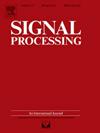频谱密集环境下宽带MIMO雷达波束成形
IF 3.4
2区 工程技术
Q2 ENGINEERING, ELECTRICAL & ELECTRONIC
引用次数: 0
摘要
在频谱密集环境下,具有恒定模量约束(cmc)的宽带MIMO雷达波束模式整形对于未来的6G网络传感技术至关重要。现有方法最小化了宽带MIMO雷达波束匹配均方误差(MSE)和空间谱零化(SSN)区域能谱密度(ESD)的加权函数;然而,实现精确的ESD控制仍然是一个挑战。为了解决这个问题,我们最小化了cmc和精确SSN约束(SSNCs)下的波束模式匹配MSE。cmc和多个ssnc的非凸性质导致了非凸二次约束规划(QCQP)问题。为了解决这个问题,我们提出了一种新的基于流形的精确惩罚(MBEP)方法。首先,我们构造了满足CCM的复圆流形(Complex Circular Manifold, CCM),并将ssnc重新表述为精确的惩罚函数,从而将问题转化为CCM上的无约束优化问题。在此基础上,提出了一种简化的拟牛顿(SQN)优化方法。最后,自适应更新惩罚因子,改进优化过程。与现有方法相比:1)本文方法实现了SSN区域ESD水平的精确控制;2) SSN区域ESD降低8.8 dB,波束方向匹配MSE降低0.02 dB。本文章由计算机程序翻译,如有差异,请以英文原文为准。
Wideband MIMO radar beampattern shaping in spectrally dense environments
Wideband MIMO radar beampattern shaping with Constant Modulus Constraints (CMCs) in spectrally dense environments is critical for future 6G networked sensing technology. Existing methods minimize the weighted function of wideband MIMO radar beampattern matching Mean Square Error (MSE) and the Energy Spectral Density (ESD) of Spatial Spectral Nulling (SSN) region; however, achieving precise ESD control remains a challenge. To address this, we minimize the beampattern matching MSE under CMCs and precise SSN Constraints (SSNCs). The non-convex nature of the CMCs and multiple SSNCs lead to a non-convex Quadratic-Constrained Quadratic Programming (QCQP) problem. To solve the problem, we propose a novel Manifold-Based Exact Penalty (MBEP) method. First, we construct the Complex Circular Manifold (CCM) to satisfy the CMCs and reformulate the SSNCs as an exact penalty function, thereby transforming the problem into an unconstrained optimization problem on the CCM. Subsequently, a Simplified Quasi-Newton (SQN) method is developed to optimize the problem on the CCM. Finally, the penalty factor is adaptively updated to improve the optimization process. Compared with existing methods: 1) the proposed method achieves precise control of the ESD level in the SSN region; and 2) the ESD in the SSN region is reduced by 8.8 dB, while the beampattern matching MSE is decreased by 0.02 dB.
求助全文
通过发布文献求助,成功后即可免费获取论文全文。
去求助
来源期刊

Signal Processing
工程技术-工程:电子与电气
CiteScore
9.20
自引率
9.10%
发文量
309
审稿时长
41 days
期刊介绍:
Signal Processing incorporates all aspects of the theory and practice of signal processing. It features original research work, tutorial and review articles, and accounts of practical developments. It is intended for a rapid dissemination of knowledge and experience to engineers and scientists working in the research, development or practical application of signal processing.
Subject areas covered by the journal include: Signal Theory; Stochastic Processes; Detection and Estimation; Spectral Analysis; Filtering; Signal Processing Systems; Software Developments; Image Processing; Pattern Recognition; Optical Signal Processing; Digital Signal Processing; Multi-dimensional Signal Processing; Communication Signal Processing; Biomedical Signal Processing; Geophysical and Astrophysical Signal Processing; Earth Resources Signal Processing; Acoustic and Vibration Signal Processing; Data Processing; Remote Sensing; Signal Processing Technology; Radar Signal Processing; Sonar Signal Processing; Industrial Applications; New Applications.
 求助内容:
求助内容: 应助结果提醒方式:
应助结果提醒方式:


